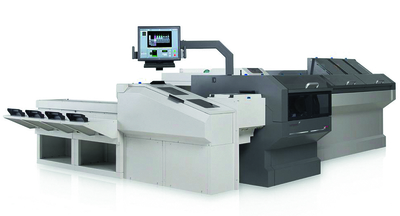The Neopost DS-1200
Print and mailing sit naturally together in most sectors of the industry, but particularly in direct mail. Digital Printer looks at the increasing convergence as printers offer mailing services and mail houses become printers.
Call it the recession, call it the natural evolution of a business, but one thing that is certain is that mailing houses are increasingly installing colour digital printing technology, while print companies are increasingly putting in mailing equipment. The convergence towards one-stop shop-ism has picked up pace with companies seeking to deliver everything that their clients need, and perhaps in some cases economic difficulty making the case even more pressing.
This is not just anecdotal either. Neopost’s marketing manager Antony Paul revealed that the mailing equipment supplier has been working with the BPIF on some research into which areas printing companies are looking to invest in going forward. It found that 22% were looking to invest in mailing and/or fulfilment technology in the future; perhaps more interestingly, 58% of that investment was additional, not just replacement kit, and about half was being considered in order to offer something new for clients.
‘What is driving convergence is that everyone wants to get a bigger share of the customer’s wallet,’ said John Ricketts, sales director for Pitney Bowes in the UK. ‘Why not exploit good relationships with extra mailing or printing services? The other thing is that with newer four colour technology, it’s accessible to the smaller mailing houses and printers, and the applications they are running are personalised, so they have to be mailed out.’
From the mailing house side, UK Postings is one company that has recently started to surf this wave, having installed a Ricoh colour press this autumn. Director Lee Bucktrout says the driving factor was to offer a wider range of services to customers, most of whom are publishers. It does not want to be a magazine printer though; it is the marketing in short runs around these customers’ publications that UK Postings sees an opportunity in.
 Lee Bucktrout, director of UK Postings
Lee Bucktrout, director of UK Postings
‘Our advantage is that we have been dealing with databases all of our working lives and we can add more value on the variable print side. We can do more clever things with the data, to change images and give our customers almost a new marketing tool,’ he told Digital Printer.
TPG Direct, a London mailing house that was purchased by The Publishing Group a year ago, has even embraced web to print to back up its Konica Minolta colour press, which is producing everything from business cards and 200-page training manuals right up to a recent 40-page high end brochure. It has found great benefits from using a Vpress web to print system, said managing partner Lincoln Hillan.
‘That really facilitates mail merging of documents ready for us to impose and print,’ he said. ‘You’ve got to find the right application for web to print. With business cards, you can leave a template on there, and it’s a repeat order every time. With DM print, every job is different really. We want to encourage customers to do a lot of the setting up themselves, but the only issue is that most of the data is poor. We can do mail merging more efficiently through Vpress. We need to mail merge to a PDF as one pass. Say you’re printing 10,000 postcards, four-up on an SRA3 sheet. We can pull out of Vpress a PDF with full colour on one side and personalisation on the other. Before we would have had to do the full colour and then put it back through to do the mail merge through Word. I just get 10,000 PDFs back from Vpress, which I can condense and impose for four-up. Then there’s variable imagery. Some clients want a 15,000 run mailer with three different letter texts, but they want the Mailsort discount across the whole lot. The web to print just handles all that complexity.’
Adjusting from mailing house to printer can call for a different mindset from the company’s sales force however. ‘They have sold publishing services for years and now we are selling digital print,’ continued UK Postings’ Lee Bucktrout. ‘With some customers, it is just educating them about these value added services that we can do, that we can be the one-stop shop for their digital printing and mailing requirements. It’s something that we need to get involved with. For the wider DM market, we would need additional kit and finishing capabilities, but I wouldn’t write it off. That’s a market we would like to grow as well as publishing.’
It is interesting that a mailing house is going for opportunities in variable data print at a time when, according to Antony Paul from Neopost, many printers believe their product has become commoditised. Neopost’s forward thinking customers are saying that their core market is under pressure, and mailing fits in as an obvious route to additional revenue.
‘It’s a fairly straight forward stepping stone if you are in DM printing to do the fulfilment as well,’ said Mr Paul. ‘It is also part of the evolution of the business, and positioning yourself as a marketing service provider. Why not handle returns and data management for clients? We are working with a lot of clients on that, educating them on how they position their business to offer this to their clients. It’s a challenge for a lot of them and that’s where we can help them make that transition.’
As indeed can companies such as Pitney Bowes, Kern and smaller equipment suppliers such as AMS and Intec. Pete Jolley, general manager at Kern UK, certainly sees the company’s role as being far more than simply supplying equipment. ‘Where we come in is in offering a consultative sale to people that have not historically got a lot of knowledge inthe enclosing and mailing of a sheet. If a company has done mailing for a long time, they already know the right questions to ask. Someone that has never bought a mail inserting system before might not know all the questions to ask. That has changed our approach as a manufacturer; we have to go through a consultative sales process.’
 Pete Jolley, general manager at Kern UK
Pete Jolley, general manager at Kern UK
Learning curve
The transition is rarely a simple one, either for printers adding mailing services or vice versa.
For printers, however, there is the learning curve of working closely with the Royal Mail and the Downstream Access (DSA) providers to go through. One company that has done it is Howard Hunt, whose assistant managing director Lucy Edwards said: ‘Post is a really complex world now. You can go down the Royal Mail retail route but that’s more expensive than DSA. The downside of DSA is it’s another supplier in the supply chain, and the paper work and reconciliation that comes with it is quite complex to maintain.
‘If we can take that away from our clients, streamline it and take that headache away, that’s definitely an advantage for us. For us, it was about consolidating that service for our clients and making their lives easier. We had to do it anyway.’
This is another area where the equipment manufacturers are worth consulting with. Neopost’s Antony Paul observed: ‘In most cases, Royal Mail is still the best option with the variety of services they offer. If the work is ad hoc, you’re better off with Royal Mail; if it is mass DM, you might do better to go with one of the DSA providers. Each of these companies has its own quirks in how it wants the mail prepared though, and if it is not done right, you can get hit by surcharges.’
Pitney Bowes’ John Ricketts agrees: ‘These printers have never really got into dealing with Royal Mail and options for mail sorting: the costs for sorted versus unsorted; do they use DSA or go direct with Royal Mail? There’s certainly a learning curve there, and that element, as well as taking some equipment on board, needs to be acknowledged. We are used to dealing with and advising in that area of the business.’
Mr Ricketts mentioned an interesting new pilot scheme that he said Royal Mail is due to start next year, using what is being called Mailmark. Formerly known as Enterprise Intelligent Barcode (EIB) this is a code that goes on the outside of the envelope that enables someone to track that document throughout the postal supply chain. ‘It’s probably the largest project Royal Mail has done from an expense point of view for a long time,’ he added.
Further factors for printers to consider are managing database hygiene for clients, and keeping accurate audit trails of mail despatched. Many organisations are struggling with database hygiene, and this has a direct bearing on the Mailsort rates, as well as the speed with which post goes through the system.
There can be quite significant postal rate reductions for presenting clean data. And with mail becoming more and more targeted, the importance of being able to mail out with a high degree of integrity also increases. In the days of mass DM, if 1 or 2% of mail packs went missing, there was a negligible effect on response rates. But now, the mailing volumes are smaller and cleverer and cost more per unit to produce; customers want to know that 100% of the batch went out in the mail, and they want there to be an audit trail to prove as much.
Direct mail print and mailing are very much natural bedfellows, but there are complexities in each discipline that any company wanting to diversify must master first. If they do, a lucrative integrated service could be there for the taking.





